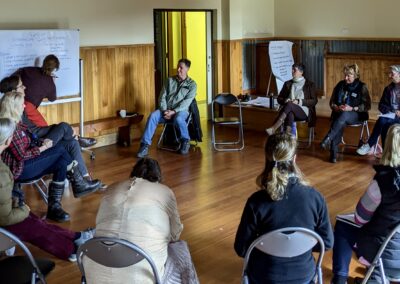Research report
How can we design out on-farm
food waste?
Food waste is a complex problem that occurs for many reasons across different parts of the
food system and supply chain. When farms can’t sell all of their produce, farmers lose money, and the resulting food waste contributes to climate change.
Some food waste is unavoidable and this report provides a summary of insights of the barriers and opportunities for farmers to sell everything they produce in order to reduce on-farm food waste, increase their return and mitigate the impact on climate change.
By facilitating the development of partnerships between farmer and buyer project participants through our ‘Whole Crop Purchasing‘ project, we are finding new models to reduce waste before the farm-gate, to share risk, and increase farmer viability.
The Whole Crop Purchasing project is supported by the Victorian Government’s Recycling Victoria Innovation Fund as part of the Circular Economy Business Innovation Centre.
Executive summary
Our ‘Whole Crop Purchasing’ project aims to prevent on-farm food waste by addressing any
shortfall that a farmer may be experiencing to sell their seasonal gluts, seconds, or to create
new, secure markets for current or forward planning crops. When farms can’t sell all of their
produce, farmers lose money, and the resulting food waste contributes to climate change. By
facilitating the development of partnerships between farmer and buyer project participants,
we are finding new models to reduce waste before the farm-gate, to share risk, and increase
farmer viability.
Reducing on-farm waste is often focused on the type of produce or commodity that is going to
waste. However we’re finding the defining feature is where farmers are at in their farming life
cycle, more so than the type of produce they farm. Farmers that are relatively new to
agriculture appear to have a greater openness (both personal interest and farm capacity) to
participate in this project.
The early stage of this research has found small to medium sized farmers can be grouped
based on their needs or context of ‘whole crop’ purchasing. We’ve come up with personas that
represent these key typologies identified. The types of farmers we have identified so far
demonstrate how the problem of on-farm food waste can stem from different contexts. It
presents varying needs and challenges pending the type of produce, scale of production and
timeframes that both farmer and potential buyer/s have to work with in order to prevent the
food becoming waste. This report covers best practice global examples of reducing on-farm
food waste, through the lens of these farmer typologies.
This project takes a circular economy approach of trying to design out waste, rather than
create reactive, end-of-pipe solutions to whole crop harvesting. The main lesson learned from
shifting away from ad hoc and opportunistic whole crop purchasing is that strong governance
is needed as part of finding new ways of sharing risk and forward planning to reduce on-farm
food waste. As part of this project’s experimentation we are trialling different forms of
agreements and governance to develop fit-for-purpose governance mechanisms that can be
replicated.
Next steps for this project include incorporating these findings into project partnerships
between farmers and buyers.
Latest Resources
Can we help?
Have an idea, a project or a question? Want help using the Open Food Network software? Get in touch and find out how we can help you with it.
Keep in touch
Join us
Create a listing, shop or group directory on the Open Food Network. Tell me more!

Read our Terms and conditions | Find us on GitHub
Open Food Network is a free and open source software platform. Our content is licensed with CC BY-SA 3.0 and our code with AGPL 3.
We take good care of your data. See our cookies policy
Open Food Network acknowledges the Aboriginal and Torres Strait Islander peoples on the unceded lands and waters across Australia. We pay our respects to Elders, past and present, honouring their rich cultures, traditions and custodianship that nourish communities and regenerate landscapes.




